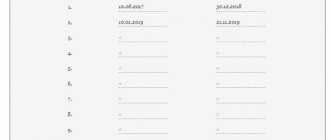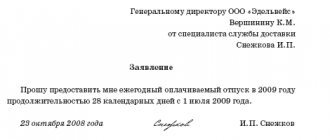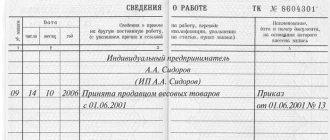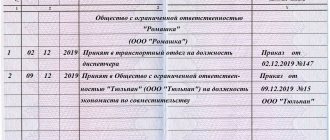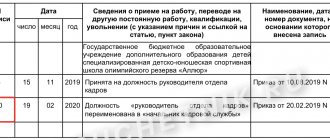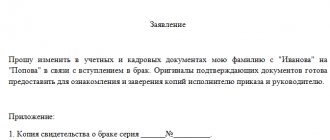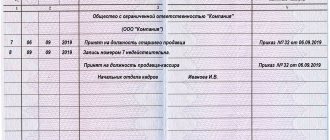Home / Labor Law / Labor Code / Work experience
Back
Published: 05/25/2016
Reading time: 9 min
0
9372
In order to calculate the duration of a person’s labor or other socially useful activity—his work experience—it is necessary to have documents confirming this activity. The main one is the citizen’s work book, in which the employer had to record the dates of hiring and dismissal.
If any periods of work are not recorded in it, the person must find any other supporting documents: extracts from orders, archival certificates, employment contracts.
- Manual calculation using a work book
- Online calculator
- Northern work experience
How to use the calculator
Instructions for using the experience calculator
- If you know your length of service as of a certain date, then enter in the “Experience as of date” field the specific day and the number of years, months, days of experience as of that day. These fields are optional, but if you have this data, it will significantly reduce your calculations.
- In the “Date of hiring” and “Date of dismissal” fields, enter your dates, for example, according to your work book. You must fill out at least one line of this table.
- The “Additional periods” may include such periods as: being in the state or municipal service, the period of work as an individual entrepreneur, the period of receiving unemployment benefits, caring for a disabled person or an elderly relative, and others. The full list of such periods is described below, in the paragraph “What is included in the insurance period”.
- Select the desired value from the drop-down lists if you served in the military or were on maternity leave.
- Click "CALCULATE". You can save the result as a doc file.
Please also take into account:
- Use the Today button (circle with a dot) to quickly insert the current date.
- Use the appropriate buttons to add, delete and clear required fields for faster and more convenient entry and change of information.
How to calculate length of service using a work book
Home / Work book
The total length of service is the total duration of all periods of a citizen’s work activity.
Information about all periods of work of an individual is reflected in the work book, which is the main document for calculating length of service.
Work experience is calculated on a calendar basis, taking into account the following mandatory conditions:
- every 30 days are taken as a full month;
- every 12 months equals 1 year.
Algorithm of actions for carrying out the calculation:
- Write down all periods of work from the work book in order.
- Calculate each individual period of employment as the difference between the date of dismissal and the date of hiring. Add one day to the final result, since the day of dismissal is considered a working day.
- Calculate the total length of service by summing up all periods of work activity.
A convenient and quick way to calculate total length of service (TS) is to use the following formula:
| OTS | = | The sum of the start dates of each interval of labor activity (in format: DD.MM.YYYY) | – | The sum of the end dates of each interval of labor activity (in format: DD.MM.YYYY) |
For clarity, here is an example of calculating seniority in two ways:
- using the formula;
- by simple arithmetic calculation.
Example of calculating work experience
The employee’s work book reflects three periods of work:
| No. | employment date | date of dismissal |
| 1 | 01.09.1997 | 30.12.2000 |
| 2 | 15.01.2001 | 30.09.2010 |
| 3 | 18.10.2010 | 28.02.2018 |
1 way:
1. Let's sum up all the periods when work began. activities:
01.09.1997 + 15.01.2001 + 18.10.2010 = 34.20.6008.
2. We sum up all periods of the end of labor. activities:
30.12.2000 + 30.09.2010 + 28.02.2018 = 88.23.6028.
3. Find the difference: 88.23.6028 – 34.20.6008 = 03.0020
4. Convert: 54 days = 1 month 24 days.
We get the result: 20 years 4 months 24 days.
5. We add 3 days, since we have 3 periods and we need to count the days of dismissal.
The total length of service of the employee is: 20 years 4 months 27 days.
Method 2:
- Duration of the first labor period. activities:
| Period 1 | Calculation | Explanation |
| Days | 30 – 1 + 1 = 30 | To the date difference we add 1 day due to dismissal |
| Months | 12 – 9 = 3 | – |
| Years | 2000 – 1997 = 3 | – |
| Total | 3 years 3 months 30 days | |
- Duration of the second labor period. activities:
| Period 2 | Calculation | Explanation |
| Days | 30 – 15 + 1 = 16 | To the date difference we add 1 day due to dismissal |
| Months | 9 – 1 = 8 | – |
| Years | 2010 – 2001 = 9 | – |
| Total | 9 years 8 months 16 days | |
- Duration of the third labor period. activities:
| Period 3 | Calculation | Explanation |
| Days | 28 – 18 + 1 = 11 | To the date difference we add 1 day due to dismissal |
| Months | 2 – 10 = – 8, 12 + 2 – 10 = 4 | Since the initial calculation resulted in a negative number, we take 1 year from the next line and convert it to months (12). |
| Years | 2018 – 2010 – 1 = 7 | We take into account the 1 year that we took when calculating in the previous line |
| Total | 7 years 4 months 11 days | |
- Let's sum up the total values of all periods:
| Period no. | Years | Months | Days |
| 1 | 3 | 3 | 30 |
| 2 | 9 | 8 | 16 |
| 3 | 7 | 4 | 11 |
| Total | 19 | 15 | 57 |
| Let's transform | -30 | ||
| +1 | <�—— | ||
| -12 | |||
| +1 | <�—— | ||
| TOTAL | 20 | 4 | 27 |
The result of the arithmetic calculation was the same: 20 years 4 months 27 days.
Did you like the article? Share on social media networks:
- Related Posts
- Application for issuance of a work book
- Entry of transfer in the work book: sample
- Entries in the labor report regarding dismissal due to circumstances beyond the control of the parties
- Changing the last name in the work book
- Application for a duplicate work record book
- Application for an insert in the work book
- Title page of the insert in the work book
- Entry about the insert in the work book
Discussion: 5 comments
- Olga:
06/30/2019 at 08:27There is an error in the very first OTS formula = the sum of the dates of dismissals minus the sum of the dates of hires. But you have it written the other way around.
Answer
- Alla Alexandrovna:
11/12/2019 at 12:56 pm
What is included in the work experience and what is not?
Answer
- Vladimir Fomich:
12/11/2019 at 15:27
It’s the 21st century, and the calculation is given for people wearing oversleeves and using an abacus. The mathematical calculation is incorrect. According to the condition, month = 30 days, year = 12 months. Our year is equal to 365 (366) days, and not 360 days as in the calculation. We get 1 period = 1217 days. ,2 period=3546 days. 3rd period=2691 days Total=7454 days. or years = [7454/30/12] = 20, months = remainder_of_division ([7454/30]/12] = 8, days = remainder_of_division (7454/30) = 14. The difference in calculations is 3 months 17 days. This is called cheating
Answer
Robert:
04/29/2020 at 18:34
Yeah, from 09/01/1997 to 02/28/2018, exactly 20 years and 6 months passed, of which 16+17 days were non-working days. How can the length of work experience be MORE than the calendar period for this period, mug? In principle, if you work only in February, April, June, September, November (exactly 5 months of experience), then you can get free ((365/12)-30) * 4 + 2 days in February = 3.66 days per year to experience and vice versa.
Answer
12/11/2019 at 19:33
Hello! Please advise me how the total length of service is calculated? Does it include parental leave and schooling?
Answer
Leave a comment Cancel reply
Legislative basis for calculating seniority
Citizens of the Russian Federation calculate their length of service according to the Federal Law “On Labor Pensions in the Russian Federation” No. 173, which entered into force on January 1, 2002.
Currently, the law does not have the concept of “work experience”; since December 31, 2001, it has been replaced by the clarified term “insurance period” , that is, the period during which a working citizen made contributions from his salary to the Pension Fund of the Russian Federation, and added other periods are legally justified for them. However, the phrase “seniority” is often used synonymously.
The insurance period is the duration of periods of work and other activities during which insurance contributions were paid to the Pension Fund of the Russian Federation.
How to calculate the insurance period
You will find the legislative basis for calculating the insurance period in Art. 13 of the Federal Law “On Insurance Pensions” No. 400-FZ dated December 28, 2013. All the nuances for calculating the insurance period, including astronauts, military personnel, sailors, and workers in hazardous industries, are listed here.
For calculations, you need a work book with all inserts. If the book is lost, the employee can provide all employment contracts with employers or confirm his work activity in court with the help of two or more witnesses. When calculating work experience, certificates from the place of work about periods of work, certificates from archives about periods of work, a military ID, and an extract from the terms of work of an individual entrepreneur are also accepted.
To calculate experience, you need:
- calculate the length of service using the work book;
- exclude periods of work abroad from the length of service;
- include in the insurance period periods when a person worked as an individual entrepreneur or farmer and paid insurance premiums for himself;
- exclude periods when the employee received a pension - for disability or labor;
- If the periods coincide, count only one.
Today, calculating the insurance period is not so difficult: data on insurance contributions is available in the Pension Fund and is stored on electronic media.
What is included in the insurance period
The legislation of the Russian Federation clearly defines the periods that are taken into account as insurance experience . These include, first of all, those months of work in which deductions were made as contributions to the Pension Fund. They may be:
- cooperation in accordance with the concluded employment contract;
- being in the state civil service;
- municipal service;
- period of work as an individual entrepreneur.
Citizens accumulate insurance experience not only during actual work, but also during other periods provided for by the Federal Law, if after or before this period the person was officially employed:
- time of military service or equivalent activity;
- the first part of maternity leave (for pregnancy and childbirth);
- the period of receiving unemployment benefits, the period of participation in paid public works and the period of moving or resettlement in the direction of the state employment service to another area for employment;
- in the case of detention of persons unjustifiably brought to criminal liability, unreasonably repressed, as well as in the case of these persons serving their sentences in places of imprisonment and exile;
- care for a baby up to 1.5 years old (separately for mom or dad);
- caring for a disabled person of group 1, a disabled child or an elderly relative who has reached the age of 80;
- for spouses of military or diplomatic representatives - the time that they accompanied their spouses and at the same time did not have the opportunity to find a job (no more than 5 years in total).
The length of service required both for calculating a pension and for sending on paid leave includes the following periods:
- actual days worked;
- weekends, holidays and time off;
- the time for retaining a position for an employee who, for some reason, does not actually perform work duties (maternity leave, vacation, sick leave, etc.);
- travel time to another location in the direction of public service;
- unjustified detention;
- forced absenteeism;
- time of public works, if they are paid.
Why calculate insurance experience?
The size of the pension depends on the insurance period; it is calculated upon retirement. The amount of sick leave benefits also depends on the length of insurance coverage. The length of sick leave is calculated on the day of the onset of temporary disability:
- for less than 5 years of experience, the benefit is 60% of the salary;
- with 5-8 years of experience, the benefit is 80% of the salary;
- with more than 8 years of experience, the benefit is 100% of the salary.
But keep in mind: the insurance period for calculating sick leave does not include periods of child care up to 1.5 years.
What is not included in the insurance period
All other periods of time not provided for by law.
Counting Features
When entering data into the calculator, you must adhere to the requirements prescribed in the relevant article of the Federal Law on the calculation of pensions.
- Calendar order . It is necessary to take into account the dates indicated in the work book or tax returns (for individual entrepreneurs). If two or more insurance periods coincide, as a rule, one of them is taken into account (more profitable for the pension recipient).
- Only RF . If a citizen has the right to a pension according to foreign laws, then to the extent that they do not coincide with the norms of the Russian Federation, this time will not be taken into account when calculating the length of service.
- Labor in subsistence farming . Self-supporting people, members of farms and various communities can include their labor time in their length of service if they have made contributions to the Pension Fund.
- Work for an individual . If a person worked for another person in accordance with a concluded contract, this period is considered an insurance period if the corresponding contributions were paid.
- Copyright royalties . Persons who sold copyrights to their works, as well as licenses, patents, etc., if they paid contributions to the Pension Fund of the Russian Federation from the funds received no less than the established amount, can include a period proportional to their contributions in their length of service.
- Does not have retroactive effect . If, according to the previously effective legislation of the Russian Federation, certain periods were included in the length of service, which was subsequently changed, they can be added to their total insurance experience.
Regarding military service
According to paragraph 3 of Article 10 of the Federal Law of May 27, 1998 N 76-FZ “On the status of military personnel”:
The time spent by citizens in military service under a contract is counted in their total length of service, included in the length of service of a civil servant and in the work experience in their specialty at the rate of one day of military service for one day of work , and the time spent by citizens in military service by conscription (in including officers called up for military service in accordance with the decree of the President of the Russian Federation) - one day of military service for two days of work .
Our calculator asks you to select the most common periods of military service. However, in specific cases, the service may not last the even periods indicated in the list, but more precise ones, containing, in addition to years, also months and days. This is especially true for contract service. In this case, we recommend that you use the “Additional periods” block instead of selecting a value from the block regarding military service. In the “Additional periods” block, you can set the beginning and end of the period of military service under the contract, in which case the calculation will be as accurate as possible.
Examples of calculating insurance period
Example 1 . An employee applies for a pension upon reaching retirement age. The work experience according to the work book is 28 years, during which time she once went on maternity leave for three years. Before that, she was an entrepreneur for 5 years.
The insurance period for calculating the pension includes only child care leave of up to 1.5 years, so we will subtract the period from 1.5 to 3 years from the insurance period. And let’s add 5 years of entrepreneurship:
28 - 1.5 + 5 = 31.5 years.
This length of service will be used to calculate the insurance part of the pension.
Example 2 . With the help of a work book, extracts from the state register and other certificates, we know about the employee’s working periods:
- length of service until 2002 is 20 years;
- from January 1, 2002 to May 16, 2009 he worked at Sosna and Oliva LLC;
- from May 25, 2009 to October 14, 2014 he worked at Melchior JSC;
- from June 10, 2014 to February 5, 2021, he worked as an individual entrepreneur.
We sum up the working periods, take into account the overlap, we get 37 years, 29 days.
Insurance experience for pension insurance
From birth, an individual has an individual account opened in the Pension Fund. This account records all pension insurance payments made by the employer or other person, including the citizen himself. The period during which contributions to the Pension Fund were paid will constitute the main part of the insurance period when calculating the pension.
Important!
There is a limit on the amount of insurance coverage from which an individual has the right to receive an old-age insurance pension. Until 2015, the condition for receiving a pension was a five-year insurance period. By 2024, the length of service required to receive a pension will be 15 years (Article 8 of Federal Law No. 400-FZ dated December 28, 2013 “On Insurance Pensions”). The transition period to increase the minimum insurance period is currently ongoing:
| Year of pension assignment | Minimum insurance period |
| 2020 | 11 years |
| 2021 | 12 years |
| 2022 | 13 years |
| 2023 | 14 years |
| 2024 and later | 15 years |
The pension due to a citizen is calculated on the basis of the individual pension coefficient. Its value, in turn, depends on the insurance period.
The rules for calculating the insurance period for the purposes of pension insurance are established by Federal Law No. 400-FZ “On Insurance Pensions”, as well as the Decree of the Government of the Russian Federation dated October 2, 2014 No. 1015 “On approval of the Rules for calculating and confirming the insurance period for establishing insurance pensions.” An employee’s insurance period includes not only work activity, but also other periods of life. The full list is specified in Article 12 of Federal Law No. 400-FZ. Let us give some examples of them:
- military service;
- periods of being on sick leave and receiving appropriate benefits;
- period of receiving unemployment benefits;
- the period of care of one of the parents for the child until he reaches one and a half years old (no more than six years in total);
- length of stay in custody or in places of detention of persons brought to criminal liability without justification, etc.
It is necessary to take into account that such periods cannot be included in the insurance period if before or after them no insurance contributions were paid to the Pension Fund for the individual.
An employee can work part-time. In this case, insurance premiums will be paid by each policyholder. However, only one of the periods can be included in the insurance period. The period for calculating the insurance period is taken based on the individual’s application.
If a citizen worked abroad, and this period was taken into account when determining a pension in another country, such a period is not included in the insurance period.
Why do you need to calculate experience?
Calculating work experience from a work book is necessary for every working citizen. The indicator is used to calculate the following social benefits:
- The right to annual paid leave is granted after a certain continuous period of work for one company.
- Receiving sick leave and temporary disability payments.
- For retirement, a calculation is needed to determine your monthly payments.
The period included in the insurance period is clearly indicated by the legislation of the Russian Federation. It includes any type of activity where a citizen paid funds to the Pension Fund:
- civil public service;
- work in municipal institutions;
- individual entrepreneurship;
- work in organizations under an employment contract.
It should be noted that experience is accumulated not only by the time spent directly in the workplace. If the employee is officially employed, then the period taken into account includes paid maternity leave (the first part is pregnancy and childbirth), business trips, caring for a person with disabilities, and caring for children under 2 years of age.
Social insurance experience
The periods of payment of social insurance contributions form the main part of the insurance period taken into account when calculating benefits:
- Maternity benefit.
If a woman’s work experience is less than six months, the amount of the monthly benefit cannot be more than the minimum wage (Article 11 of the Federal Law of December 29, 2006 No. 255-FZ), which from 2021 is 12,130 rubles. If the period worked is greater than or equal to one half a year, payments will be calculated based on 100% of average earnings.
- Temporary disability benefit.
Depending on the length of the insurance period, the amount of benefits is determined:
- up to 5 years of experience - the benefit is determined as 60% of average earnings;
- experience from 5 to 8 years - 80% of average earnings;
- 8 years of experience or more - 100% of average earnings.
When calculating sick leave payments, there is also a limitation of 6 months of insurance experience: less than this period, benefits are accrued in an amount not exceeding the minimum wage.
The procedure for calculating length of service for determining maternity benefits and sick leave is established by Art. 16 of the Federal Law of December 29, 2006 No. 255-FZ and Order of the Ministry of Health and Social Development of Russia of February 6, 2007 No. 91. The period of contribution includes the periods of deduction of contributions, as well as other periods listed in Part I of the Order.
Unlike pension insurance, with social insurance the length of service does not include periods of work under the GPC. There are other discrepancies between these types of insurance experience. For example, social insurance does not take into account periods of official unemployment, unjustified detention, etc.

